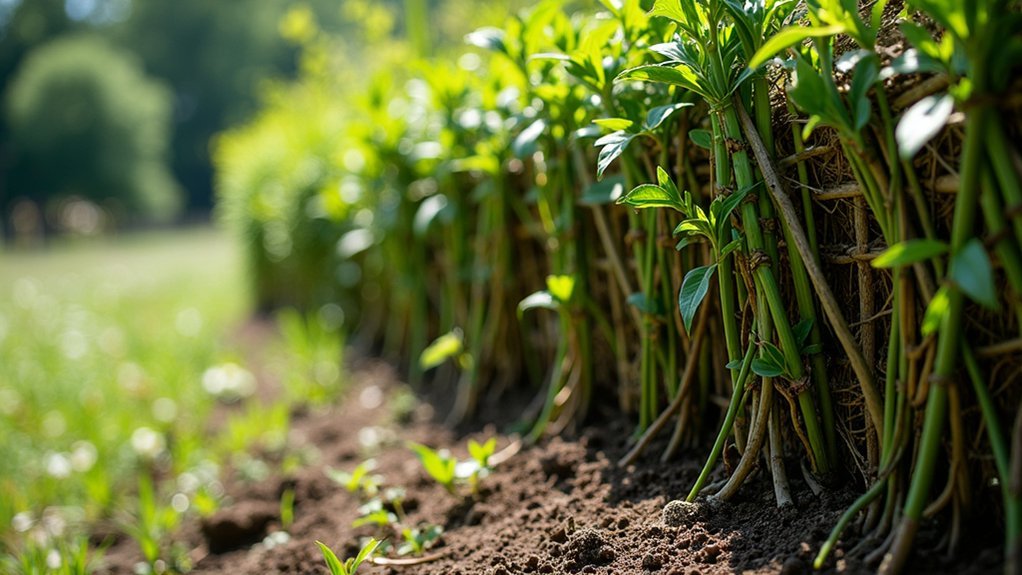For successful willow fence erosion control: First, select dormant-season cuttings at least 18 inches long and half-inch thick, cutting the thicker end to a point. Second, plant stakes at a 45-degree angle with one-third underground and 2-3 buds above soil level. Third, apply mulch to retain moisture and suppress competing vegetation while monitoring water levels regularly. These living barriers establish extensive root systems that strengthen over time to provide lasting slope stabilization.
Selecting and Preparing Willow Cuttings for Maximum Rooting Success

When establishing a willow fence for erosion control, proper selection and preparation of cuttings directly impact your success rate. Choose willow cuttings at least 18 inches long and half-inch thick, with longer options for dry planting sites to reach adequate moisture essential for healthy growth.
Harvest cuttings during dormant season (late fall to early spring) to preserve liveliness. Cut the thicker end to a point and keep the narrower end flat to guarantee correct orientation during planting.
Dormant-season willow harvesting preserves vitality, while proper cutting techniques ensure successful orientation when establishing erosion barriers.
Plant cuttings deep enough—half to two-thirds of their length—in moist soil to enhance stability and prevent erosion.
After planting, monitor soil moisture regularly, especially during the first few weeks. Maintain consistent moisture without waterlogging to encourage robust rooting success and establish an effective living barrier.
Proper Installation Techniques for Erosion-Resistant Willow Fences
To establish a resilient willow fence that effectively combats erosion, you’ll need to follow specific installation techniques that maximize both stability and growth potential. Insert your willow cuttings at a precise 45-degree angle, ensuring at least one-third of each 18-inch cutting is underground with 2-3 buds remaining above soil level. This angle helps stabilize soil while promoting ideal root development.
Different soil types require adjustments to your approach—maintain consistent moisture levels without creating conditions for root rot.
After planting, apply mulch around each cutting to retain hydration and suppress competing vegetation. Consider installing protective fencing if wildlife browsing threatens your young willows.
For challenging slopes, plant multiple rows of cuttings to create a thorough erosion control system that will strengthen as the willows mature.
Essential Maintenance Practices for Long-Term Erosion Control

Maintaining your willow fence requires consistent attention beyond the initial installation phase if you want it to effectively control erosion for years to come.
Monitor moisture levels regularly, as willow trees can consume up to 200 gallons of water daily while developing their extensive root systems for stabilizing soil.
Willows thirst for up to 200 gallons daily as they develop the powerful root networks that anchor your soil.
Apply mulch around your willows to preserve soil moisture and regulate temperature during the growing season.
This also reduces competition from weeds that might compromise erosion control effectiveness.
Perform light pruning to promote healthy growth and stronger root development.
Protect young stakes from herbivores using protective sleeves or safe repellents to guarantee their survival.
Check that stakes remain properly angled at 45 degrees with 3 inches above ground to withstand water and wind forces while maximizing their soil-stabilizing potential.
Frequently Asked Questions
Are Willow Trees Good for Erosion Control?
Yes, willow trees are excellent for erosion control. You’ll find they’re highly effective with their extensive root systems, ability to absorb 200 gallons of water daily, and rapid growth in wet, unstable soils.
How Do You Maintain a Willow Fence?
You’ll need to trim branches annually, keep soil moist, apply mulch to suppress weeds, prune dead limbs promptly, and protect young shoots from animals. Regular maintenance guarantees your willow fence remains healthy and effective.
How to Stop Erosion on a Fence Line?
To stop erosion on your fence line, plant willow stakes that’ll root deeply, stabilize soil, and create a natural barrier. Keep them well-watered initially, add mulch around the base, and monitor regularly for effectiveness.
What Time of Year Do You Root Willow Cuttings?
You’ll have the most success rooting willow cuttings during the dormant season, from late fall through early spring. Plant them in early spring after frost passes or in fall to establish roots before winter.
In Summary
Willow fences offer a natural, effective solution for erosion control when properly implemented. Remember to select healthy cuttings, plant them during dormancy, and install them correctly with proper spacing and depth. Don’t forget regular maintenance—watering, weeding, and pruning—especially during the first year. With these three essential steps, you’ll create a living barrier that strengthens over time while beautifully stabilizing your vulnerable slopes and banks.





Leave a Reply